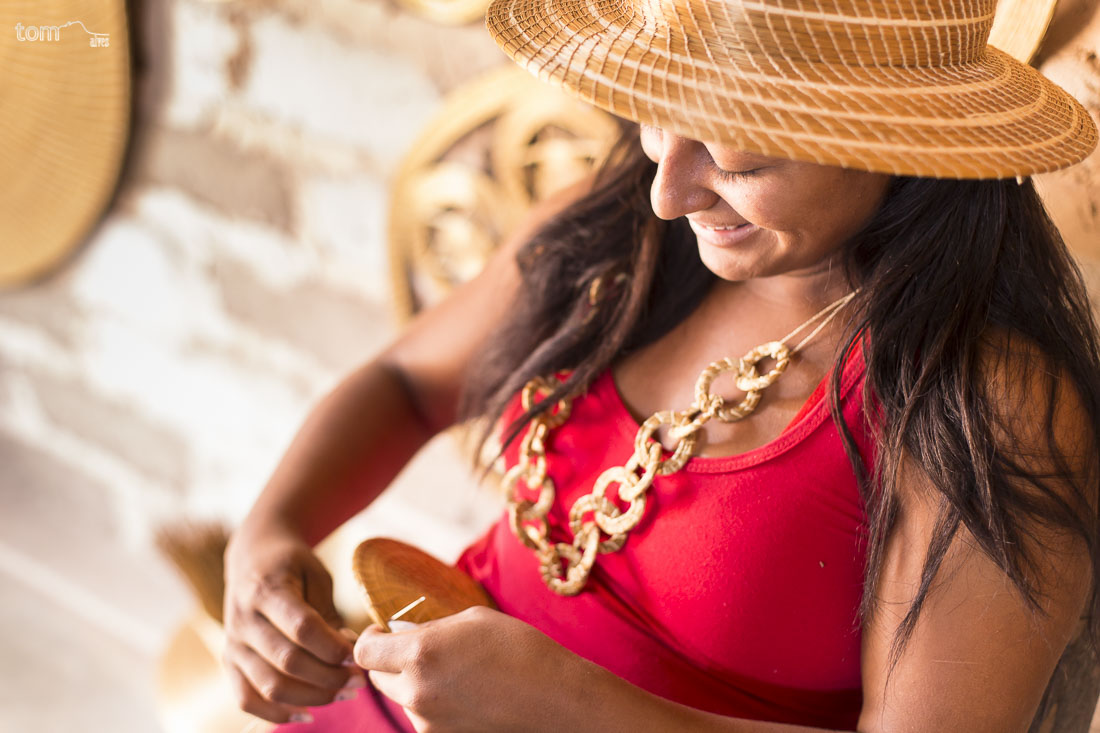Crafts with buriti leaves and golden grass threads, sewing cultures and knowledge from generation to generation
Through know-how, the communities of the village of Mumbuca, in Mateiros/TO have created collections that mix innovation and traditional techniques such as the natural dyeing of the buriti silk thread


Credit: Tom Alves / Disclosure
By: Gabriel Murga – Lupa do Bem / Favela em Pauta
The tradition of handicraft with golden grass, the “gold of the cerrado”, was passed on by the Xerente Indians who at the beginning of the 20th century walked along the side of the Araguaia River, passed through the quilombola village of Mumbuca and taught some residents to “sew grass”. ” with buriti silk. Since then, this knowledge has been passed on from generation to generation. This is the mission of the Associação Capim Dourado do Povoado Mumbuca (Capim Dourado Association of the Mumbuca Village).
The golden grass threads are sewn with the fine fiber of buriti leaves, both species native to Brazil, typical of the cerrado. In this way, the artisans produce a great diversity of pieces, such as hats, baskets, vases, mandalas, trays, bio-jewels, lamps and others.
The female presence is remarkable in Mumbuca in the leadership and organization of the community. Women make up the Associação do Capim Dourado – Capim Dourado Association -, being responsible for the production of handicrafts, sales and distribution of earnings.

Based on this know-how, communities have created new collections with product innovations and the insertion of new materials, such as seeds, coconut pieces, and new traditional techniques, such as the natural dyeing of the buriti silk thread.
Thus, the artisans who previously produced objects that were present in their daily lives with the technique of braiding grass and buriti fibers, such as the hats that protect the farmers in the fields, baskets and other utensils, now produce the most varied pieces.


Recognition and economic boost from the hands of Jalapão artisans
After the quilombola recognition process promoted by the Palmares Cultural Foundation, Mumbuca and other communities began to receive greater external attention, which boosted artisanal production.
Capim Dourado Association was created in 2000 by a group of artisans who felt the need to formally organize themselves for the management of golden grass and to encourage the commercialization of handicrafts that, today, constitute the main source of income for communities residing within the Park. State of Jalapão.
The strength of these women also lies in avoiding the mediation of the raw material intermediary, ensuring greater access to it. The Association has played an important role with other communities housed in the Jalapão State Park in the debate around strategies that guarantee both the sustainability of the region and the strengthening of local culture and knowledge.


Despite the name golden grass, the thin golden stems that paint the Jalapão landscape golden are not grass, but an evergreen, a very resistant plant that, even after being harvested, remains luxuriant for a long time. It is a plant of the cerrado, being the golden grass, specifically, native to the Jalapão region.
The struggle to transform the State Park into a Sustainable Development Reserve
On the right bank of the Tocantins River is the village of Mumbuca, 35 km from the city of Mateiros, in the heart of Jalapão. The quilombola community Mumbuca was founded by blacks, freed slaves and direct descendants of slaves who migrated from the Bahian hinterland and settled in the region, adopting the cerrado as their great mother.
From the miscegenation with Indians, mainly with indigenous women, probably from the Xerente ethnic group, at the end of the 18th century, an Afro-indigenous community was formed, in which almost all of them have some degree of kinship.


The indigenous presence in the local culture is expressed in the name of the village itself, “Mumbuca”, which in the indigenous language means “blue bee”, a common species in the region. In the social organization of the community, men and women have different roles.
The men take care of the plantation where they grow manioc, potatoes, beans, corn, among others, and the women harvest and prepare the flour, in addition to dedicating themselves to handicrafts.
Jalapão consists of an Environmental Conservation Unit with more than 34 thousand kilometers of desertified area that involves the municipalities of Lagoa do Tocantins, Lizarda, Mateiros, Novo Acordo, Ponte Alta do Tocantins, Santa Tereza do Tocantins and São Félix do Tocantins.


It is one of the few places that has a considerable area of preserved savannah, where fields of golden grass are found. The harvest is done once a year, at the beginning of spring, together with sowing, during which the Harvest Festival takes place in the village. As respect for the harvest season is crucial for the plant’s survival, a law was created that regulates its collection.
How to support and accompany the Capim Dourado Association of the Mumbuca Village


To follow the association’s work, access the Artesol website. To directly support the initiative, contact the email associa.mumbuca@gmail.com


